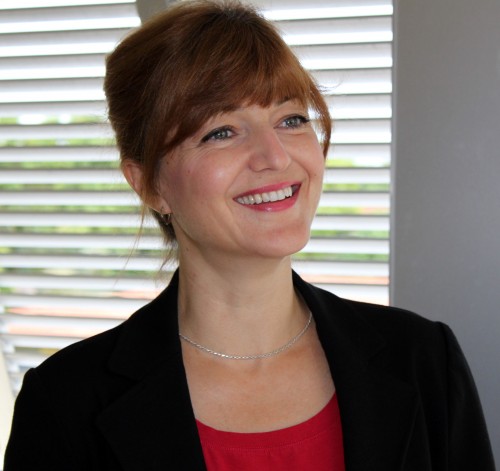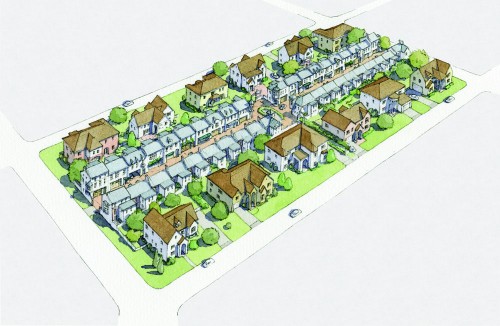 Galina Tachieva.Driving the highways and byways of America’s endless exurbs and suburbs can be pretty depressing. Strip mall after megamall after subdivision after strip mall fans out from every city in the country — with much of that development sitting vacant or in foreclosure. Even the sprawl has sprawl these days.
Galina Tachieva.Driving the highways and byways of America’s endless exurbs and suburbs can be pretty depressing. Strip mall after megamall after subdivision after strip mall fans out from every city in the country — with much of that development sitting vacant or in foreclosure. Even the sprawl has sprawl these days.
It’s a problem even if you’re a dedicated suburbanite. Commutes are long and congested, office space sits vacant, and green space gets eaten up to build new malls and developments as the old ones become obsolete.
So, can this mess be fixed?
That’s the question Galina Tachieva tackles in her recent book, The Sprawl Repair Manual. Tachieva is partner and director of town planning at Duany Plater-Zyberk & Company in Miami, Fla. — the firm of urbanist eminence Andrés Duany.
Tachieva, who is originally from Bulgaria, said she wrote the book because she saw an urgent need for a toolkit that could be used by planners, developers, and government officials in their efforts to build more livable communities. The book is filled with specific examples and illustrations of how to take places like abandoned malls, with their oceanic parking lots, and turn them into mixed-use developments where people can live, work, and shop in pleasant surroundings.
I talked with Tachieva recently about the vanishing promise of suburbia, the opportunities created by the foreclosure crisis, and the vexing problem of Florida. This is an edited version of our conversation.
Q. When people start talking about increasing density, there is often a defensiveness from people who live in suburbs and like what suburbs represent. They think that somehow their way of life is under attack by people who advocate greater density.
A. Yes. That’s very clear, and that’s why we wanted to make the case for sprawl repair as a kind of method which will enhance people’s lives. We will provide amenities for the people who will live there. Appropriate places — whether they are malls, shopping centers, large commercial parks. If the method is explained basically as a process of improving their access to things in daily life — the simple shopping needs or whatever the daily needs are of a person — this will alleviate the situation. Right now, basically, the big promise of suburban living is lost, especially with the foreclosures and everything.
Q. Why do you think that sprawl repair is such an important issue for planners and for communities?
A. It was a topic that I have been studying and researching for a while. Our office has been working on retrofitting projects and sprawl for quite a while. The current economic conditions led me to this idea that this is now a very convenient time, a very good time, actually, to put together a more systematic, more comprehensive approach, a kind of comprehensive method for sprawl repair.
Q. You talk about the economic opportunities that the foreclosure crisis has created. At the same time, it seems like people have less and less money to do big projects. Financing has become very difficult for a lot of developers. How do you see those things balancing out?
A. Of course, right now it’s very difficult to even think about any large project. However, there is a whole range of tools which are prepared for very different economic conditions and for very different scales. That is why the whole method is structured from the bigger picture of the region going all the way down to the community scale and all the way down to the block or the building, to be able to respond to different economic conditions.
It might be a government, regional organization, or municipality thinking about their future development as a larger place, as a region. Or it might be a developer who can maybe intervene in one block, who can actually take advantage of some of the foreclosures — maybe acquire a block of some of these foreclosed properties, and do something on a much smaller scale. And all the way down to the single building. People are thinking about the second generation of some of these suburban building sites coming through the next cycle.
 One proposal for increasing density in a McMansion development.Q. I was looking at the single-family subdivision section — the idea of say, taking these backyards of McMansions and putting townhomes in there. It looks very appealing on paper to someone like myself, but how can you sell people who want McMansions on that idea?
One proposal for increasing density in a McMansion development.Q. I was looking at the single-family subdivision section — the idea of say, taking these backyards of McMansions and putting townhomes in there. It looks very appealing on paper to someone like myself, but how can you sell people who want McMansions on that idea?
A. First, can we point out some examples how it was done in the past. Most of them are abandoned properties or foreclosed properties. They will be acquired as a group, let’s say. So it’s an opportunity for a neighborhood which is actually going down to do something different. It’s like a tool that they can use. This is number one.
In a good economic situation, this can also be something to be contemplated. In Boston, there are many big McMansions which are converting into multifamily, with some families in the back on the same block. The real estate prices were actually very high. This example was inspired by a real situation, but with the opposite economic situation, when the real estate prices were very high. The desirability of the place was so high that it made sense to develop a different model. Some of these townhouses have underground parking, because it was worth doing.
Q. So you’re seeing a real appetite for sprawl repair when you go out and talk to people.
A. Absolutely. I see a big opportunity because people want to retire in their own places. They want to stay in their communities. They don’t want to move out. These people are in suburbia, they are in second and third generation development. What are we going to do? Displace them? Tell them to go to the city? No.
The millennials, they will still be attracted to Manhattan and the big, vital places. However, they may not be able to afford these places. My son is dying to go to Manhattan. But guess what? He works in Columbus. Columbus is not the worst place he can be. He wants to be in Manhattan, but his livelihood is in Columbus. The smaller places, the suburbs, third and second generation, they need to have these opportunities. And it will happen because the market will require it.
Q. A friend of mine who lives in Florida said to me, “Ask her if she can fix Florida.”
A. Florida is a very interesting example. Of course, it’s the ultimate example of sprawl, the poster child. We have been trying to fix Florida for 30 years, you can reply to your friend.
In Florida, even with all the stuff that has been done in terms of sprawling in a big way, there was also very aggressive thinking about how to fix things. Actually in Florida, there are a whole range of retrofits which are being implemented. Downtown Kendall here in Miami is one big example. Mizner Park, which is in Boca Raton, is the first mall transformation.
There is already historical precedent in Florida, so it’s not going to b
e difficult either from a regulatory point of view, nor from the point of view of convincing people, because the best thing to do is show them examples. When they have an example, they see it built, they’re like, oh, this is what you mean. It’s not just the density. It’s the nice street — your kids will have a place to go to the theater, you can live there, work there, everything is in close proximity. I believe that there is a good future in Florida.
It’s not going to be only Florida to fix. I’m going to a conference in Rome — they are looking at fixing their suburbs. They are sick and tired of the congestion and the sprawling characteristics.
Q. They just don’t have the amount of land that we have.
A. Yes. Here we had a big party.
Q. I was recently in Las Vegas and was surprised to find myself in a neighborhood that’s not like what I think of in Las Vegas, a new neighborhood that has very interesting designs. They have roundabouts. There was a mall with a Starbucks, for instance, on the perimeter of the lot, and the parking inside behind that, the supermarket behind. We sat at the Starbucks and people were walking their dogs up and down the sidewalk, clearly coming from their residences. It was pretty interesting to see in a brand-new neighborhood.
A. They have the idea of what people want, what people need. They just have to look around and see what people will want in the future. I think that they will be doing it. It’s still moving slowly — it’s like a big machine that has to turn around – but it’s happening all around the country. It’s very, very obvious that it’s already setting in the public consciousness that our ways of doing things are probably over, and we have to be more aggressive and more forward-thinking, do the right thing this time around. When you see this tremendous waste, you wonder: Where’s the common sense in doing this? So hopefully, we can think of an optimistic future, even though it’s hard to imagine it.



